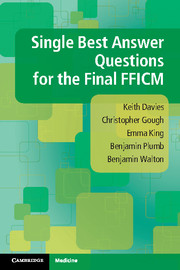Book contents
- Single Best Answer Questions for the Final FFICM
- Single Best Answer Questions for the Final FFICM
- Copyright page
- Contents
- Preface
- Exam A: Questions
- Exam A: Answers
- Exam B: Questions
- Exam B: Answers
- Exam C: Questions
- Exam C: Answers
- Exam D: Questions
- Exam D: Answers
- Exam E: Questions
- Exam E: Answers
- Exam F: Questions
- Exam F: Answers
- Exam G: Questions
- Exam G: Answers
- Exam H: Questions
- Exam H: Answers
- Index
- References
Exam B: - Answers
Published online by Cambridge University Press: 21 January 2017
- Single Best Answer Questions for the Final FFICM
- Single Best Answer Questions for the Final FFICM
- Copyright page
- Contents
- Preface
- Exam A: Questions
- Exam A: Answers
- Exam B: Questions
- Exam B: Answers
- Exam C: Questions
- Exam C: Answers
- Exam D: Questions
- Exam D: Answers
- Exam E: Questions
- Exam E: Answers
- Exam F: Questions
- Exam F: Answers
- Exam G: Questions
- Exam G: Answers
- Exam H: Questions
- Exam H: Answers
- Index
- References
Summary
A 77-year-old woman is admitted to hospital with malaise, muscle weakness, nausea, palpitations and paraesthesia. Her regular medications include amiloride, lisinopril, atenolol, digoxin and naproxen. She has recently started a course of trimethoprim for a urinary tract infection. Her blood pressure is 85/55 mmHg. An electrocardiogram (ECG) is performed.
- Type
- Chapter
- Information
- Single Best Answer Questions for the Final FFICM , pp. 54 - 89Publisher: Cambridge University PressPrint publication year: 2016

